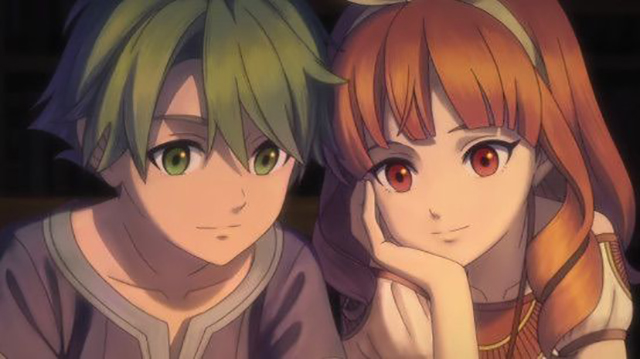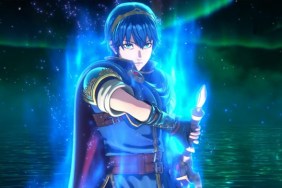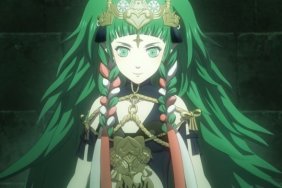The tale of Fire Emblem’s resurgence as a franchise over the past half-decade is one not easily believed, and is a comeback not often accomplished in gaming. After being single-handedly saved by 2013’s stellar Awakening (complete with addicting marriage system and matchmaking) the series reached new heights of popularity upon scoring pharaonic representation in Super Smash Bros, subsequently splintering itself across multiple versions Pokémon-style with 2015’s Fates.
Such rapid proliferation makes it easy to forget that the series has been around since 1990, the entire time crafted by one of Nintendo’s oldest development partners in Intelligent Systems (of Super Metroid, Advance Wars, and WarioWare fame). Fire Emblem Echoes: Shadows of Valentia is a full-on remake of 1992’s Gaiden, released only in Japan for Famicom and defining franchise rules and precedent as the series’ second entry. Despite that game’s age, Shadows of Valentia is a total overhaul, flush with updated art, cutscenes, characters, and environments. It’s not technically a brand new Fire Emblem, but it’s every bit as worth playing.
A Tale of Two Destinies

What grabbed me about Echoes right away is its stylistic shift from both Fates and Awakening, the series’ prior two entries. If those games toned down the outrageous anime overtones found in previous titles (no more bright green hair), Shadows of Valentia goes further still; there’s a grit and realistic detail to characters and environments that at times feels almost American. Certain characters, such as protagonist Alm’s grandfather Sir Mycen, are downright naturalistic, like a GTA loading screen had kids with old-school Dungeons and Dragons. This is largely thanks to character designer Hidari, and while I’ll always adore the work of Yosuke Kozaki, for Echoes this is a welcome change.
Shadows of Valentia’s story follows dual protagonists, Alm and Celica, as they fight to liberate their kingdom of Zofia against an opposing Rigellian invasion. Childhood friends, they were separated at a young age, and as the game progresses you play as versions of their respective older selves, guiding each toward destiny and their own path of self discovery. Celica’s tale in particular is invigorating; Fire Emblem is no stranger to male heirs approaching (or defying) divine fate, but the story of what it means to be a woman in a war-torn state (and not a damsel at that) is one that has long begged further exploration. In this area Echoes delivers, with Celica’s account providing a perhaps softer, more authentic narrative experience, while Alm’s side takes up the usual (but effective) everyman coming into his own trajectory. It’s not long before paths collide, but the disparate nature of distinct protagonists from the get-go is an excellent touch.
Read Your Way Out
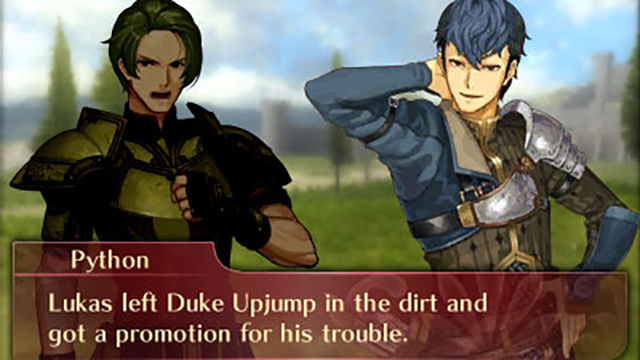
Part of what makes all of this so effective are entirely new systems for Fire Emblem, as Shadows of Valentia borrows heavily from, of all things, visual novels. The world map of Awakening and Birthright has been reinstated, and in addition to traditional grid-based battles and strategic skirmishes the series is known for, certain locales can actually be visited, explored, and traversed. The primary means of doing so is the most VN-like; locales are portrayed via detailed backdrop illustrations, taken in a first-person view. Drawn 2D NPCs populate these areas Danganronpa style, most of whom are anxious to chat about Zofia goings-on, village gossip, or anything else that might be on their mind. Varied common folk are interspersed with members of your own army, who will appear in-environment to discuss events, offer backstory, or deal tips and key information. If you’re not talking, there’s also an “examine” function, which turns these environments into something resembling Zero Escape puzzle rooms, where items can be gathered and everything can be analyzed (complete with text-box reactions and punny quips at every turn). You can also gather weapons and gear this way, and make sure you do – some of Echoes’ best and most valuable combat items are unassumingly placed in such environments, easily passed over if you’re not paying attention.
Also new is dungeon crawling, something not before seen in any Fire Emblem title to date. This is handled with a Zelda-like 3rd person perspective and a bottom-screen map, slowly revealing itself as new areas are explored. Unlike the aforementioned visual novel elements (a wonderful match for Fire Emblem that I’d love to see retained for future Echoes remakes), dungeon crawling is rather pedestrian, but that doesn’t mean it’s bad. Said sections would never cut it as their own game, but as a change of pace they work just fine, providing an engaging means of collecting random items and trinkets in the environment. Perhaps more importantly, dungeons facilitate battles with brigands, undead creatures known as “terrors,” and more: basically, they’re Shadows’ opportunity for grinding. I found that simply not fleeing racked up enough experience points to progress unimpeded, even on Hard mode with permadeath enabled, so if you avoid constant retreat things should work out just fine. There’s no need to overdo it battling nameless foes when they respawn either.
Rout the Enemy
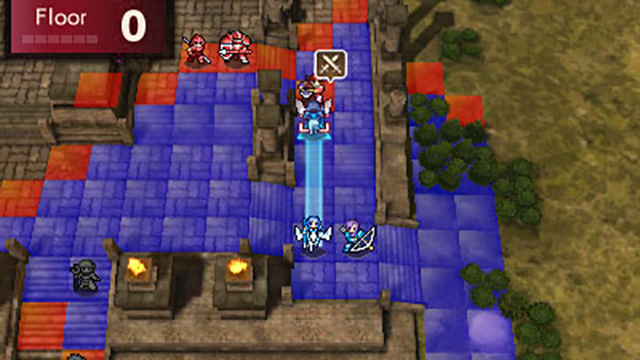
Dungeons also contain Mila statues, a key mechanic for maintaining and upgrading your combat units that finally brings me to the bread and butter of any Fire Emblem: the actual strategy gameplay. The battle system of the original Gaiden is definitely old-school, yet Intelligent Systems has done such an elegant job of primping it for modern exposure that it feels more like a fascinating tour through a strategy RPG museum than anything irksome or inconvenient. Weapon durability is nowhere to be found (a trait copied recently by Fates), as units are instead furnished with base weapons by default, which are improved by equipping superior versions via held item. There’s strategy to item management itself, as each unit only has a single item slot; if you decide you want to carry some goat cheese for HP recovery, you’re going to be stuck with the base, generic “lance” as a result. It sounds obtuse but didn’t take long to catch on, and before long I welcomed the system as a refreshing break from mainline Fire Emblem. Beyond that, it further cements my belief that Nintendo ought to establish Echoes as a continuous spin-off series, with decided influence from visual novels, dungeon-crawlers, and the not-so-distant past.
Also key to your battle strategy are Combat Arts, similar to the modern games’ Skills but again unlocked and achieved in a rather roundabout manner. The Combat Arts you unlock depend on the item you decide to hold; as such, simply slapping the same piece on the same unit throughout the game may not be the best strategy. As you progress you’ll begin to discover which items yield what, for example equipping my Pegasus Knight Faye with a leather shield yielded the “Swap” ability, enabling her to switch places with a teammate on the battlefield and remove him from harm. It may seem like the obvious choice is to simply enhance a unit’s clear strengths further with items (ie give shields to Knights and Generals), but it doesn’t have to be so simple.

Arming my Pegasus Knights with shields rendered them impressively resistant to normally devastating archers, thus able to fly over walls and parapets to eliminate ranged threats in a way that would not otherwise be possible. As mentioned, goddess statues (a deity known here as Mila) are interspersed throughout dungeons and VN-locales for unit upgrades, allowing you to re-class as necessary and restore your army’s morale by making small offerings. I imagine Mila is tired of receiving endless chunks of moldy old bread from me, but hey, it gets the job done. Regardless, Shadows of Valentia’s gameplay is the very definition of an acquired taste, but once acquired is a refined blend that feels far more historic than it does outdated. For series fans, the variety is wholly welcome.
Conclusion
It’s difficult to imagine executing a remake of a near 30-year-old experience more effectively and efficiently than Intelligent Systems has, applying just the right amount of refinement and new ideas to antique gameplay systems that clearly still work. One objective shortcoming is the lack of map and win condition variety (“rout the enemy” is all too common), but with battlefield support conversations and multiple strategic approaches to keep you busy, it’s unlikely to bother most. Add in superb character design, captivating anime cutscenes from Studio Khara, and the aforementioned visual novel garnish that so effectively ties everything together (there’s voice acting too) , and you have the epitome of what a quality remake ought to look like.
My one wish to Nintendo is that they either keep the Echoes sub-series going or consider applying some of these changes to new Fire Emblem games; they’re really that good, and what’s been concocted here deserves to be more than a series one-off. The charming, reliquian nature of the game may not appeal to everyone, but if you like Fire Emblem, strategy, and can appreciate gaming history, then there’s absolutely zero reason not to pick this up.
Griffin Vacheron is an Editor at GameRevolution. You can follow him on Twitter @novacav.
A 3DS copy of Fire Emblem Echoes: Shadows of Valentia was provided by its publisher. This game is exclusive to 3DS.
-
Early Fire Emblem gameplay and style refined for the modern day
-
Heavy visual novel influence is a huge success, ought to be considered for future entries
-
New writing, localization, and character art are all top-notch
-
Outdated combat elements have been repurposed to feel vintage, and bring new layers of strategy
-
Anime cutscenes and full voice acting are both of high quality
-
Some players may find the lack of map variety and win conditions tiresome
-
Dungeon-crawling, though adequate, is a bit repetitive and vanilla
